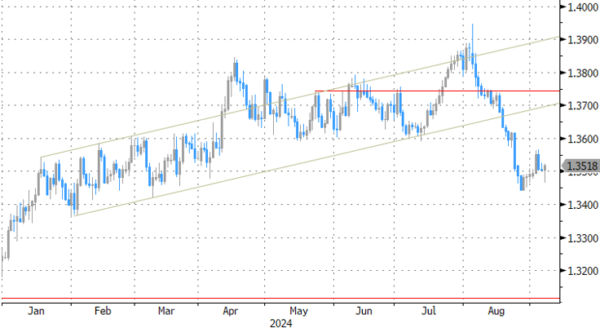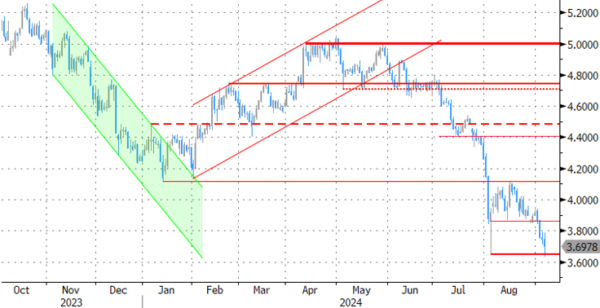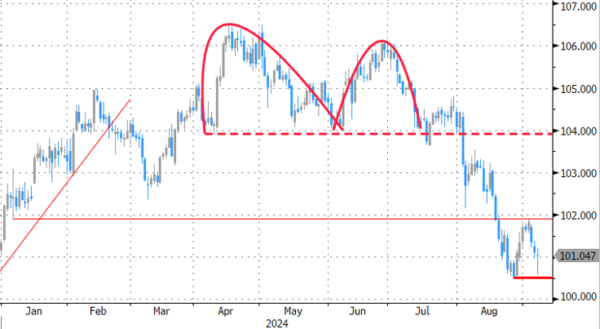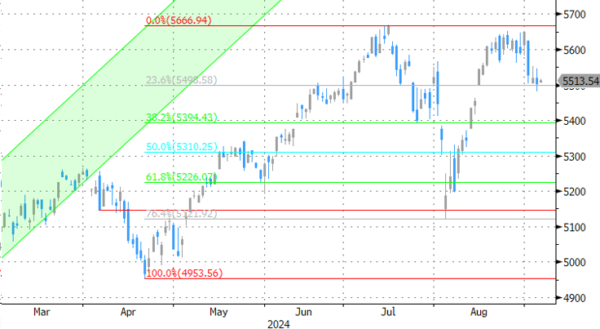Markets
August nonfarm payrolls to settle the debate once and for all… Or not. The US economy added 142k jobs in August, compared to 165k consensus. Most other metrics printed near consensus as well. The unemployment rate ticked lower from 4.3% to 4.2%, the participation rate stabilized at 62.7% and wage growth even accelerated somewhat more than expected (to 0.4% M/M and 3.8% Y/Y). However, as we feared the report needed to be perfect across the board to stop recent market momentum (shifting towards 50 bps rate cuts). And it wasn’t. June and July payrolls faced a combined downward revision of 86k, making the total miss some 109k. It explains why US Treasuries extended their rally after some initial volatility with new cycle lows (in yields) across the curve. The jury remains out though with investors building in some caution ahead of the weekend. The dollar initially suffered from the loss of interest rate support. The trade-weighted greenback came close to testing the December 2023 & August 2024 low at 100.50. USD/JPY similarly aimed at 141.70. EUR/USD set an intraday high at 1.1155 to currently trade back near opening levels at 1.1111. NY Fed Williams said it’s appropriate to start a process of rate cuts. He didn’t comment on the potential size of a first move. By not pushing back against a 50 bps liftoff, we think it’s similar to giving the agreeing nod. A speech by Fed Waller on the economic outlook is still scheduled later today. We hold our view that the Fed could this year opt for three consecutive rate cuts by 50 bps.
Focus turns to Europe next week as the ECB is expected to cut its deposit rate for a second time this year by 25 bps, to 3.50%. As announced in March, they will also reduce the spread between the main refinancing rate and the deposit rate from the current 50 bps to only 15 bps implying an MRR rate cut of 60 bps, from 4.25% to 3.65%. Updated GDP and CPI forecasts will be closely watched for clues on the monetary policy trajectory going forward. However, we don’t expect big changes apart from perhaps some minor downward revisions to this year’s GDP and headline CPI data. Recall that ECB staff in June plotted a 0.9%-1.4%-1.6% growth path for 2024-2026 and a 2.5%-2.2%-1.9% inflation trajectory. While keeping an easing bias, we don’t expect the central bank to pre-commit to specific actions at coming meetings. The short intermeeting period between September 12 and October 17 suggests that bar any big surprise, the central bank might be more inclined to sit the October meeting out and stick with the currently, quarterly, rate-reduction scheme with a next 25 bps move coming only in December. Unlike the Fed, the ECB’s options for making policy less restrictive are smaller given limited room towards neutral territory in the current, stubborn, (core) inflationary environment.
News & Views
The Food and Agricultural Organization’s Food Price Index eased slightly to 120.7 points in August. Decreases in sugar prices, meat and cereals outweighed increases in vegetable oils and dairy products. The y/y index is down 1.1%. Breaking down into its components, the cereal price index fell on dropping wheat exports prices. The vegetable oil index was up 1 point to the highest level since January 2023. Indonesian output remained below full potential, lifting world palm oil prices more than enough to offset lower prices for soy, sunflower and rapeseed oil. Dairy prices (+2.8 points) rose thanks to surging import and tight supplies driving those for milk. Butter quotations reached an all-time high. Falling poultry and pig prices (lacklustre import vs ample export stock) weighed down on the meat price index (-0.9 points). Sugar, finally, fell to the lowest level since October 2022 (-5.7 points) on an improving production outlook for the 2024/2025 season in Thailand and India.
• Canadian payrolls came in at 22.1k in August, the first net job growth in three months’ time. It was, however, slightly less than the 25k hoped-for and came fully on the account of part-time employment (+65.7k vs -43.6k full-time jobs shed). The unemployment rate rose to a higher-than-expected 6.6%, which was the highest since May 2017 barring the 2020-2021 pandemic period. Statistics Canada describes August employment as “little changed”, extending the status quo to four months. Today’s numbers confirm the ongoing cooling of the labour market and vindicate the Bank of Canada which cut rates earlier this week for a third time straight. The 25 bps pace may be upped to 50 bps in October, depending on the economic data. Canadian money markets price in a cumulative 100 bps of cuts over the remaining two meetings of 2024. The fallout for the Canadian Loonie is contained thanks to broad USD weakness. USD/CAD is trading just south of the 1.35 big figure.
Graphs
USD/CAD: Loonie and USD weakness cancel each other out
US 2-yr yield sets minor new cycle low after downward payrolls revisions
Trade-weighted dollar (DXY) comes close to testing Dec23/Aug24 low as payrolls fail to break reigning (50 bps rate cut) momentum
S&P 500: neutral start as key indices try to avoid a further drop















